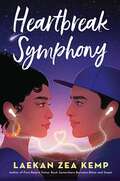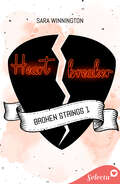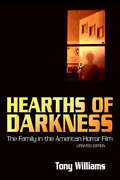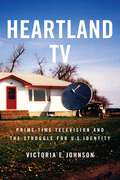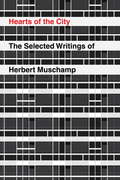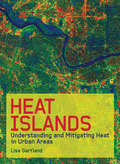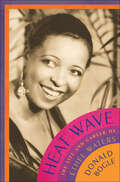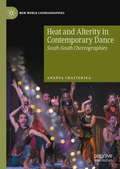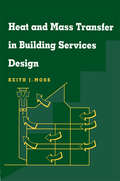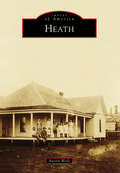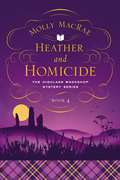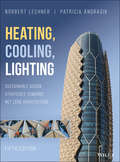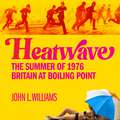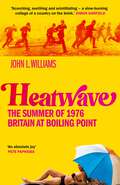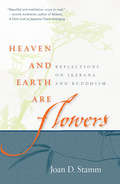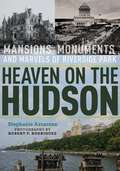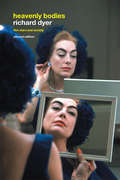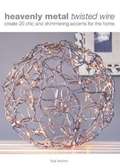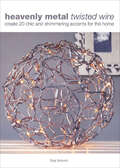- Table View
- List View
Heartbreak Symphony
by Laekan Zea KempClap When You Land meets On the Come Up in this heart-gripping story about navigating first love and overcoming grief through the power of music. Aarón Medrano has been haunted by the onstage persona of his favorite DJ ever since his mother passed away. He seems to know all of Aarón&’s deepest fears, like how his brain doesn&’t work the way it should and that&’s why his brother and father seem to be pushing him away. He thinks his ticket out is a scholarship to the prestigious Acadia School of Music. That is, if he can avoid blowing his audition.Mia Villanueva has a haunting of her own and it&’s the only family heirloom her parents left her: doubt. It&’s the reason she can&’t overcome her stage fright or believe that her music is worth making. Even though her trumpet teacher tells her she has a gift, she&’s not sure if she&’ll ever figure out how to use it or if she&’s even deserving of it in the first place. When Aarón and Mia cross paths, Aarón sees a chance to get close to the girl he&’s had a crush on for years and to finally feel connected to someone since losing his mother. Mia sees a chance to hold herself accountable by making them both face their fears, and hopefully make their dreams come true. But soon they&’ll realize there&’s something much scarier than getting up on stage—falling in love with a broken heart.
Heartbreaker (Broken Strings #Volumen 1)
by Sara Winnington¿Qué ocurre cuando el amor y el odio colisionan? Descubre la fuerza de la música y la pasión en la serie Broken Strings. Cuando Alyssa Jones entra en el Concorde como candidata para ser la nueva cantante de Broken Strings, sabe que las cosas van a cambiar en su vida. Y de qué manera. Allí la esperan los ojos cautivadores del guitarrista, Paul Rush, el rompecorazones de la banda, que gracias a la música tiene un ligue nuevo a la semana. La rutina de seductor de Paul da un vuelco al conocer a la nueva vocalista, Alyssa: tanto ella como su sonrisa son su talón de Aquiles. Y, si quiere conquistarla, tendrá que dejar a un lado algunos de los rasgos más... «encantadores» de su personalidad. Por su bien, el del grupo y por el del Concorde. Porque la vida es muy complicada, y hay más fuerzas que se mueven en contra de los Broken Strings, tratando de cerrarles la sala de conciertos y lugarde ensayos. Y Alyssa y Paul tendrán que trabajar juntos para intentar evitarlo. Dos vidas diferentes. Dos personas unidas por la música. Un mismo objetivo.
Hearths of Darkness: The Family in the American Horror Film, Updated Edition
by Tony WilliamsHearths of Darkness: The Family in the American Horror Film traces the origins of the 1970s family horror subgenre to certain aspects of American culture and classical Hollywood cinema. Far from being an ephemeral and short-lived genre, horror actually relates to many facets of American history from its beginnings to the present day. Individual chapters examine aspects of the genre, its roots in the Universal horror films of the 1930s, the Val Lewton RKO unit of the 1940s, and the crucial role of Alfred Hitchcock as the father of the modern American horror film. Subsequent chapters investigate the key works of the 1970s by directors such as Larry Cohen, George A. Romero, Brian De Palma, Wes Craven, and Tobe Hooper, revealing the distinctive nature of films such as Bone, It's Alive, God Told Me To, Carrie, The Exorcist, Exorcist 2, The Texas Chainsaw Massacre, as well as the contributions of such writers as Stephen King. Williams also studies the slasher films of the 1980s and 1990s, such as the Friday the 13th series, Halloween, the remake of The Texas Chainsaw Massacre, and Nightmare on Elm Street, exploring their failure to improve on the radical achievements of the films of the 1970s.After covering some post-1970s films, such as The Shining, the book concludes with a new postscript examining neglected films of the twentieth and early twenty-first century. Despite the overall decline in the American horror film, Williams determines that, far from being dead, the family horror film is still with us. Elements of family horror even appear in modern television series such as The Sopranos. This updated edition also includes a new introduction.
Heartland TV: Prime Time Television and the Struggle for U.S. Identity
by Victoria E. JohnsonWinner of the 2009 Society for Cinema and Media Studies Katherine Singer Kovacs Book AwardThe Midwest of popular imagination is a "Heartland" characterized by traditional cultural values and mass market dispositions. Whether cast positively —; as authentic, pastoral, populist, hardworking, and all-American—or negatively—as backward, narrow–minded, unsophisticated, conservative, and out-of-touch—the myth of the Heartland endures.Heartland TV examines the centrality of this myth to television's promotion and development, programming and marketing appeals, and public debates over the medium's and its audience's cultural worth. Victoria E. Johnson investigates how the "square" image of the heartland has been ritually recuperated on prime time television, from The Lawrence Welk Show in the 1950s, to documentary specials in the 1960s, to The Mary Tyler Moore Show in the 1970s, to Ellen in the 1990s. She also examines news specials on the Oklahoma City bombing to reveal how that city has been inscribed as the epitome of a timeless, pastoral heartland, and concludes with an analysis of network branding practices and appeals to an imagined "red state" audience.Johnson argues that non-white, queer, and urban culture is consistently erased from depictions of the Midwest in order to reinforce its "reassuring" image as white and straight. Through analyses of policy, industry discourse, and case studies of specific shows, Heartland TV exposes the cultural function of the Midwest as a site of national transference and disavowal with regard to race, sexuality, and citizenship ideals.
Hearts of the City
by Nicolai Ouroussoff Herbert MuschampFrom the late Herbert Muschamp, the former architecture critic of The New York Times and one of the most outspoken and influential voices in architectural criticism, a collection of his best work.The pieces here--from The New Republic, Artforum, and The New York Times--reveal how Muschamp's views were both ahead of their time and timeless. He often wrote about how the right architecture could be inspiring and uplifting, and he uniquely drew on film, literature, and popular culture to write pieces that were passionate and often personal, changing the landscape of architectural criticism in the process. These columns made architecture a subject accessible to everyone at a moment when, because of the heated debate between modernists and postmodernists, architecture had become part of a larger public dialogue. One of the most courageous and engaged voices in his field, he devoted many columns at the Times to the lack of serious new architecture in this country, and particularly in New York, and spoke out against the agenda of developers. He departed from the usual dry, didactic style of much architectural writing to playfully, for example, compare Frank Gehry's Guggenheim Bilbao to the body of Marilyn Monroe or to wax poetic about a new design for Manhattan's manhole covers. One sees in this collection that Muschamp championed early on the work of Frank Gehry, Rem Koolhaas, Zaha Hadid, Thom Payne, Frank Israel, Jean Nouvel, and Santiago Calatrava, among others, and was drawn to the theoretical writings of such architects as Peter Eisenman. Published here for the first time is the uncut version of his brilliant and poignant essay about gay culture and Edward Durrell Stone's museum at 2 Columbus Circle. Fragments from the book he left unfinished, whose title we took for this collection--"A Dozen Years," "Metroscope," and "Atomic Secrets"--are also included. Hearts of the City is dazzling writing from a humanistic thinker whose work changed forever the way we think about our cities--and the buildings in them.
Heat Islands: Understanding and Mitigating Heat in Urban Areas
by Lisa Mummery GartlandHeat islands are urban and suburban areas that are significantly warmer than their surroundings. Traditional, highly absorptive construction materials and a lack of effective landscaping are their main causes. Heat island problems, in terms of increased energy consumption, reduced air quality and effects on human health and mortality, are becoming more pressing as cities continue to grow and sprawl. This comprehensive book brings together the latest information about heat islands and their mitigation. The book describes how heat islands are formed, what problems they cause, which technologies mitigate heat island effects and what policies and actions can be taken to cool communities. Internationally renowned expert Lisa Gartland offers a comprehensive source of information for turning heat islands into cool communities. The author includes sections on cool roofing and cool paving, explains their benefits in detail and provides practical guidelines for their selection and installation. The book also reviews how and why to incorporate trees and vegetation around buildings, in parking lots and on green roofs.
Heat Pump Controls to Exploit the Energy Flexibility of Building Thermal Loads (Springer Theses)
by Thibault PéanThis book describes different control strategies adapted to heat pumps, at the purpose of increasing energy flexibility in buildings. It reports on the development of both simple rule-based controls (RBC) and advanced model predictive controls (MPC). These are tested and compared in both simulation and experimental setups. The book analyzes in detail all the different steps, including the development and tuning of the controllers, their testing in experimental settings and simulation studies. Bridging between advanced control systems theory concepts and practical needs, and discussing the advantages and main challenges of MPC and RBC controllers in terms of efficiency of heat pump operation, electricity prices, emission values, and users’ comfort, this book offers an in-depth evaluation of innovative control strategies applied to energy demand management in buildings.
Heat Pump Planning Handbook
by Jürgen BoninThe Heat Pump Planning Handbook contains practical information and guidance on the design, planning and selection of heat pump systems, allowing engineers, designers, architects and construction specialists to compare a number of different systems and options. Including detailed descriptions of components and their functions and reflecting the current state of technology this guide contains sample tasks and solutions as well as new model calculations and planning evaluations. Also economic factors and alternative energy sources are covered, which are essential at a time of rising heat costs. Topics included: Ecological and economic aspects Introduction to Refrigeration Water heat pump systems Configuration of all necessary components Planning Examples (Problems and Solutions)
Heat Pumps for Sustainable Heating and Cooling (Green Energy and Technology)
by Y. H. Lun S. L. TungThis book highlights the significance of using sustainable energy to prevent the deterioration of our planet using heat pumps. Energy sustainability can be achieved through improved energy efficiency. In this regard, heat pumps offer an energy-efficient alternative for heating and cooling. To drive the adoption of heat pumps as a key component of sustainable buildings, the authors focus on examining sustainable practices in heat pump operations and innovative system design. In view of the growing desire to use sustainable energy to meet heating and cooling demands and improve indoor air quality, this book offers a valuable reference guide to the available options in HVAC (heating, ventilation, and air-conditioning) system design. To begin with, the authors define sustainable energy and discuss the trend of “thinking green” in building design. They then discuss sustainable practices and heat pump applications in mapping out HVAC systems. In turn, they examine the use of green operations to promote sustainable practices and, in order to highlight the importance of innovative design, discuss the configuration options and precision control aspects. In closing, the authors illustrate innovative sustainable design on the basis of several energy-efficient cases. The book’s main goal is to drive the adoption of sustainable energy solutions. Heat pumps, it argues, represent the most efficient system for meeting commercial/recreational/residential heating and cooling demands. The book not only examines industrial practices in heat pump application, but also discusses advanced heat pump technologies and innovative heat pump designs.
Heat Wave: The Life and Career of Ethel Waters
by Donald BogleFrom the author of the bestselling Dorothy Dandridge comes a dazzling look at one of America's brightest and most troubled theatrical stars.Almost no other star of the twentieth century reimagined herself with such audacity and durable talent as did Ethel Waters. In this enlightening and engaging biography, Donald Bogle resurrects this astonishing woman from the annals of history, shedding new light on the tumultuous twists and turns of her seven-decade career, which began in Black vaudeville and reached new heights in the steamy nightclubs of 1920s Harlem. Bogle traces Waters' life from her poverty-stricken childhood to her rise in show business; her career as one of the early blues and pop singers, with such hits as "Am I Blue?," "Stormy Weather," and "Heat Wave"; her success as an actress, appearing in such films and plays as The Member of the Wedding and Mamba's Daughters; and through her lonely, painful final years. He illuminates Waters' turbulent private life, including her complicated feelings toward her mother and various lovers; her heated and sometimes well-known feuds with such entertainers as Josephine Baker, Billie Holiday, and Lena Horne; and her tangled relationships with such legends as Irving Berlin, Duke Ellington, Harold Clurman, Elia Kazan, Count Basie, Darryl F. Zanuck, Vincente Minnelli, Fred Zinnemann, Moss Hart, and John Ford.In addition, Bogle explores the ongoing racial battles, growing paranoia, and midlife religious conversion of this bold, brash, wildly talented woman while examining the significance of her highly publicized life to audiences unaccustomed to the travails of a larger-than-life African American woman.Wonderfully atmospheric, richly detailed, and drawn from an array of candid interviews, Heat Wave vividly brings to life a major cultural figure of the twentieth century—a charismatic, complex, and compelling woman, both tragic and triumphant.
Heat and Alterity in Contemporary Dance: South-South Choreographies (New World Choreographies)
by Ananya ChatterjeaThis book argues that contemporary dance, imagined to have a global belonging, is vitiated by euro-white constructions of risk and currency that remain at its core. Differently, the book reimagines contemporary dance along a “South-South” axis, as a poly-centric, justice-oriented, aesthetic-temporal category, with intersectional understandings of difference as a central organizing principle. Placing alterity and heat, generated via multiple pathways, at its center, it foregrounds the work of South-South artists, who push against constructions of “tradition” and white-centered aesthetic imperatives, to reinvent their choreographic toolkit and respond to urgent questions of their times. In recasting the grounds for a different “global stage,” the argument widens its scope to indicate how dance-making both indexes current contextual inequities and broader relations of social, economic, political, and cultural power, and inaugurates future dimensions of justice.
Heat and Mass Transfer in Building Services Design
by Keith MossBuilding design is increasingly geared towards low energy consumption. Understanding the fundamentals of heat transfer and the behaviour of air and water movements is more important than ever before. Heat and Mass Transfer in Building Services Design provides an essential underpinning knowledge for the technology subjects of space heating, water services, ventilation and air conditioning. This new text: *provides core understanding of heat transfer and fluid flow from a building services perspective *complements a range of courses in building services engineering *underpins and extends the themes of the author's previous books: Heating and Water Services Design in Buildings; Energy Management and Operational Costs in Buildings Heat and Mass Transfer in Building Services Design combines theory with practical application for building services professional and students. It will also be beneficial to technicians and undergraduate students on courses in construction and mechanical engineering.
Heath (Images of America)
by Austin WellsWhen John O. Heath first settled in the area now known as Heath in 1848, wild turkey and deer were as plentiful as the area's timber and rich, black soil. The fertile land and convenient location along the east fork of the Trinity River prompted several settlers to follow the Heath family's lead, and Heath experienced steady growth in the early 1900s, with several businesses and schools in operation. Life was hard in those days, with food and money hard to come by, but locals found sanctuary in social gatherings, endless games of 42, mink hunting in the winter, and baseball. Heath's economy was given a big lift when the lake adjacent to the community, known as Lake Ray Hubbard, was filled in 1969 after a seemingly endless rain. With the attraction of the lake and developments that stemmed from it, such as the Rush Creek Yacht Club, Heath now faces the challenge of maintaining steady growth while continuing to stick to its roots as a charming, tight-knit community with an open countryside atmosphere.
Heather and Homicide: The Highland Bookshop Mystery Series: Book 4
by Molly MacRaeThe new novel in the acclaimed Highland Bookshop mystery series finds a true-crime author murdered in the charming seacoast town of Inversgail—can the women of Yon Bonnie Books discover the killer&’s identity before he or she strikes again?True crime writer Heather Kilbride arrives in the seacoast town of Inversgail, Scotland, to research a recent murder for her new book. But if that&’s true, why does she seem more interested in William Clark, a shadowy lawyer with no connection to the murder? Her nosy questions arouse the suspicions of Constable Hobbs, the members of a local writers&’ group, and Janet Marsh and her crew of amateur sleuths at Yon Bonnie Books. Heather&’s unconventional research methods prove deadly when Janet discovers her lifeless body. Except the &“body&” turns out to be a dummy dressed-up to look like Heather. Meanwhile, Heather is sitting at a safe distance observing Janet&’s reactions. Then Heather is found dead—again—sprawled at the base of an ancient standing stone; and this time it&’s for real. Clutched in her hand is a valuable miniature book last seen at Yon Bonnie Books, and now the police want to know how Heather, the miniature book, and Janet are all connected. But Janet and her group of sleuths have two questions of their own: Who else is interested in knowing that connection—and is that person a cold-blooded killer?
Heating, Cooling, Lighting
by Norbert LechnerSustainable environmental control through building designHeating, Cooling, and Lighting is the industry standard text on environmental control systems with the emphasis on sustainable design. By detailing the many factors that contribute to the comfort in a building, this book helps architects minimize mechanical systems and energy usage over the life of the building by siting, building design, and landscaping to maximize natural heating, cooling, and lighting. This new fourth edition includes new information on integrated design strategies and designing for the Tropics. Resources include helpful case studies, checklists, diagrams, and a companion website featuring additional cases, an image bank, and instructor materials.Designing buildings that require less energy to heat, cool, and light means allowing the natural energy of the sun and wind to reduce the burden on the mechanical and electrical systems. Basic design decisions regarding size, orientation, and form have a great impact on the sustainability, cost, and comfort of a building. Heating, Cooling, and Lighting provides detailed guidance for each phase of a design project. Readers will:Understand the concept of sustainability as applied to energy sourcesReview the basic principles of thermal comfort, and the critical role of climateLearn the fundamentals of solar responsive design, including active and passive solar systems as well as photovoltaicsDiscover how siting, architectural design, and landscaping can reduce the requirements for mechanical and electrical systemsIn sustainable design, mechanical, and electrical systems should be used to only accomplish what the architect could not by the design of the building itself. With this in mind, designers require a comprehensive understanding of both the properties of energy and the human factors involved in thermal comfort. Heating, Cooling, and Lighting is the complete, industry-leading resource for designers interested in sustainable environmental control.
Heating, Cooling, Lighting: Sustainable Design Strategies Towards Net Zero Architecture (Coursesmart Ser.)
by Norbert M. Lechner Patricia AndrasikThe essential guide to environmental control systems in building design For over 25 years Heating, Cooling, Lighting: Sustainable Design Strategies Towards Net Zero Architecture has provided architects and design professionals the knowledge and tools required to design a sustainable built environment at the schematic design stage. This Fifth Edition offers cutting-edge research in the field of sustainable architecture and design and has been completely restructured based on net zero design strategies. Reflecting the latest developments in codes, standards, and rating systems for energy efficiency, Heating, Cooling, Lighting: Sustainable Design Strategies Towards Net Zero Architecture includes three new chapters: Retrofits: Best practices for efficient energy optimization in existing buildings Integrated Design: Strategies for synergizing passive and active design Design Tools: How to utilize the best tools to benchmark a building's sustainability and net zero potential Heating, Cooling, Lighting: Sustainable Design Strategies Towards Net Zero Architecture is a go-to resource for practicing professionals and students in the fields of environmental systems technology or design, environmental design systems, construction technology, and sustainability technology.
Heatwave: The Summer of 1976 – Britain at Boiling Point
by John L Williams'Grippingly captures the three months that shook Britain's cultural landscape' PAULINE BLACK'Scorching, seething and scintillating, Heatwave conjures a slow-burning collage of a country on the brink. I lived through those cruel months, and Williams recreates them with intense skill' SIMON GARFIELD'An absolute joy' PETE PAPHIDES'Engrossing...powerful...goes way beyond nostalgia' DAVID KYNASTONWith temperatures soaring to 35ºC, severe water shortages and a sunburned population queuing at the standpipes, the summer of 1976 was always remembered as Britain's hottest.But the wave that hit the UK that year was also cultural and political, with upheaval on the streets, in parliament, on the cricket pitch and on the radios and TV sets of a nation at a crossroads.Before this blistering summer, Britain seemed stuck in the post-war era, a country where people were all in it together - as long as you were white, male and straight. In July, Tom Robinson writes a song called Glad to be Gay, and by August bank holiday, Black youth are making the police run for their lives in the almighty riot at the Notting Hill Carnival. But with the Labour Prime Minister Harold Wilson suddenly quitting, the pound sinking and the economy tanking, a restless immigrant population and increasing dissatisfaction in the old world order, the weather seemed to boil up the country to the point where the lid blows off.Weaving a rich tapestry of the news stories of the year, with social commentary and dozens of first-person interviews with those that were there at the time, Williams's reappraisal of the summer of '76 is an evocative, sometimes nostalgic but always an unflinching read. Heatwave takes us back to relive the events of that summer and asks - have we really moved on as much as we would have liked?
Heatwave: The Summer of 1976 – Britain at Boiling Point
by John L Williams'Grippingly captures the three months that shook Britain's cultural landscape' PAULINE BLACK'Scorching, seething and scintillating, Heatwave conjures a slow-burning collage of a country on the brink. I lived through those cruel months, and Williams recreates them with intense skill' SIMON GARFIELD'An absolute joy' PETE PAPHIDES'Engrossing...powerful...goes way beyond nostalgia' DAVID KYNASTONWith temperatures soaring to 35ºC, severe water shortages and a sunburned population queuing at the standpipes, the summer of 1976 was always remembered as Britain's hottest.But the wave that hit the UK that year was also cultural and political, with upheaval on the streets, in parliament, on the cricket pitch and on the radios and TV sets of a nation at a crossroads.Before this blistering summer, Britain seemed stuck in the post-war era, a country where people were all in it together - as long as you were white, male and straight. In July, Tom Robinson writes a song called Glad to be Gay, and by August bank holiday, Black youth are making the police run for their lives in the almighty riot at the Notting Hill Carnival. But with the Labour Prime Minister Harold Wilson suddenly quitting, the pound sinking and the economy tanking, a restless immigrant population and increasing dissatisfaction in the old world order, the weather seemed to boil up the country to the point where the lid blows off.Weaving a rich tapestry of the news stories of the year, with social commentary and dozens of first-person interviews with those that were there at the time, Williams's reappraisal of the summer of '76 is an evocative, sometimes nostalgic but always an unflinching read. Heatwave takes us back to relive the events of that summer and asks - have we really moved on as much as we would have liked?
Heatwave: The Summer of 1976 – Britain at Boiling Point
by John L Williams'Grippingly captures the three months that shook Britain's cultural landscape' PAULINE BLACK'Scorching, seething and scintillating, Heatwave conjures a slow-burning collage of a country on the brink. I lived through those cruel months, and Williams recreates them with intense skill' SIMON GARFIELD'An absolute joy' PETE PAPHIDES'Engrossing...powerful...goes way beyond nostalgia' DAVID KYNASTONWith temperatures soaring to 35ºC, severe water shortages and a sunburned population queuing at the standpipes, the summer of 1976 was always remembered as Britain's hottest.But the wave that hit the UK that year was also cultural and political, with upheaval on the streets, in parliament, on the cricket pitch and on the radios and TV sets of a nation at a crossroads.Before this blistering summer, Britain seemed stuck in the post-war era, a country where people were all in it together - as long as you were white, male and straight. In July, Tom Robinson writes a song called Glad to be Gay, and by August bank holiday, Black youth are making the police run for their lives in the almighty riot at the Notting Hill Carnival. But with the Labour Prime Minister Harold Wilson suddenly quitting, the pound sinking and the economy tanking, a restless immigrant population and increasing dissatisfaction in the old world order, the weather seemed to boil up the country to the point where the lid blows off.Weaving a rich tapestry of the news stories of the year, with social commentary and dozens of first-person interviews with those that were there at the time, Williams's reappraisal of the summer of '76 is an evocative, sometimes nostalgic but always an unflinching read. Heatwave takes us back to relive the events of that summer and asks - have we really moved on as much as we would have liked?
Heaven and Earth Are Flowers
by Joan D. StammIn this lovely meditation on ikebana - the Japanese art of flower arranging - Joan Stamm shows us how her twin paths of Buddhist practice and artistic endeavor converge and indeed become thoroughly intertwined. Stamm's lush, elegant voice weaves childhood memories of her mother's joy at a just-bloomed morning glory with meditations on the symbolic importance of bamboo, of pine, of the lily. She takes us with her on her travels to Japan as she learns the essential principles of ikebana, and lets us join her as she teaches flower arranging to women in a nursing home who, though they won't recall tomorrow the rules of arrangement or even the flowers' names, nonetheless partake in the joy and love that celebrates all living things, however briefly they endure. And, when Joan shows us the natural symmetry of a blossom, we find that we too have regained our balance. Includes 16 full-color photographs of the author's original ikebana.
Heaven on the Hudson: Mansions, Monuments, and Marvels of Riverside Park
by Stephanie AzzaroneWinner, Victorian Society in America Book AwardA colorful tale of a singular New York City neighborhood and the personalities who make it specialTo outsiders or East Siders, Riverside Park and Riverside Drive may not have the star status of Fifth Avenue or Central Park West. But at the city’s westernmost edge, there is a quiet and beauty like nowhere else in all of New York. There are miles of mansions and monuments, acres of flora, and a breadth of wildlife ranging from Peregrine falcons to goats. It’s where the Gershwins and Babe Ruth once lived, William Randolph Hearst ensconced his paramour, and Amy Schumer owns a penthouse. Told in the uniquely personal voice of a longtime resident, Heaven on the Hudson is the only New York City book that features the history, architecture, and personalities of this often overlooked neighborhood, from the eighteenth century through the present day.Combining an extensively researched history of the area and its people with an engaging one-on-one guide to its sights, author Stephanie Azzarone sheds new light on the initial development of Riverside Park and Riverside Drive, the challenges encountered—from massive boulders to “maniacs”—and the reasons why Riverside Drive never became the “new Fifth Avenue” that promoters anticipated. From grand “country seats” to squatter settlements to multi-million-dollar residences, the book follows the neighborhood’s roller-coaster highs and lows over time. Readers will discover a trove of architectural and recreational highlights and hidden gems, including the Drive’s only freestanding privately owned villa, a tomb that’s not a tomb, and a sweet memorial to an eighteenth-century child. Azzarone also tells the stories behind Riverside’s notable and forgotten residents, including celebrities, murderers, a nineteenth-century female MD who launched the country’s first anti-noise campaign, and an Irish merchant who caused a scandal by living with an Indian princess.While much has been written about Central Park, little has focused exclusively on Riverside Drive and Riverside Park until now. Heaven on the Hudson is dedicated to sharing this West Side neighborhood’s most special secrets, the ones that, without fail, bring both pleasure and peace in a city of more than 8 million.
Heavenly Bodies: Film Stars and Society (Bfi Cinema Ser.)
by Richard DyerRichard Dyer's classic study of movie stars and stardom has been updated, with a new introduction by the author discussing the rise of celebrity culture and developments in the study of stars since publication of the first edition in 1986. Dyer's illuminating study is based around case studies of three major stars: Marilyn Monroe, Paul Robeson and Judy Garland. He draws on a wide range of sources, including the films in which each star appeared, to illustrate how each star's persona was constructed, and goes on to examine each within the context of particular issues in fan culture and stardom. Students of film and cultural studies will find this an invaluable part of there course reading.
Heavenly Days: The Story of Fibber McGee and Molly
by Charles Stumpf Tom PriceThis book thoroughly recounts the lives of Fibber McGee and Molly and their supporting cast.
Heavenly Metal Twisted Wire
by Lisa BrownBring a radiant dimension to your home, garden and gifts with the unique, versatile and quirky qualities of wire and metal 20 tempting projects range from pretty cards and glowing lanterns to fluttering butterfly wind chimes, an irresistibly sweet mirror frame and a decadent beaded chandelier Creative craft techniques such as embossing, beading and decoupage combine with simple wirework and metalwork Stylish, detailed photography offers essential support and invaluable inspiration
Heavenly Metal Twisted Wire: Create 20 Chic and Shimmering Accents for the Home
by Lisa BrownBring a radiant dimension to your home, garden and gifts with the unique, versatile and quirky qualities of wire and metal20 tempting projects range from pretty cards and glowing lanterns to fluttering butterfly wind chimes, an irresistibly sweet mirror frame and a decadent beaded chandelierCreative craft techniques such as embossing, beading and decoupage combine with simple wirework and metalworkStylish, detailed photography offers essential support and invaluable inspiration
